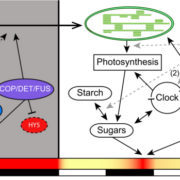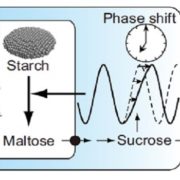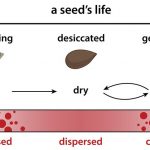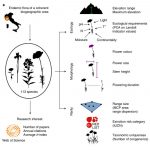Guard cell endomembrane Ca2+-ATPases underpin a ‘carbon memory’ of photosynthetic assimilation that impacts on water-use efficiency (Nature Plants)
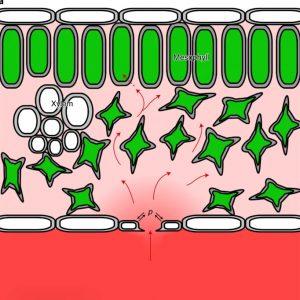 Stomatal guard cells control both carbon dioxide uptake and transpirational water loss. Guard cell control over the stomatal pore aperture is sensitive to water status (through ABA) as well as the amount of CO2 available within the leaf air space. Several studies have indicated that stomatal aperture can be improved and made more responsive for optimal water-use efficiency. Here, Jezek, Silva-Alvim, Hills, et al. combined modeling studies (using the OnGuard system) and experimental approaches to further identify guard cell control systems. They found key roles for endomembrane-localized ATP-driven calcium pumps (Ca2+-ATPases) and calcium channels, which collectively affect the concentration of cytosolic calcium ions ([Ca2+]i), which affect the other membrane transporters involved in stomatal responses. Specifically, they found that as CO2 levels fluctuate rapidly, stomatal closure responses are slowed, and this is exacerbated in mutants with deceased levels of Ca2+-ATPases. Thus, the Ca2+ stores determine a latency or ‘carbon memory’ that affects stomatal kinetics. These findings demonstrate the utility of models for identifying targets for future optimization. (Summary by Mary Williams @PlantTeaching) Nature Plants 10.1038/s41477-021-00966-2
Stomatal guard cells control both carbon dioxide uptake and transpirational water loss. Guard cell control over the stomatal pore aperture is sensitive to water status (through ABA) as well as the amount of CO2 available within the leaf air space. Several studies have indicated that stomatal aperture can be improved and made more responsive for optimal water-use efficiency. Here, Jezek, Silva-Alvim, Hills, et al. combined modeling studies (using the OnGuard system) and experimental approaches to further identify guard cell control systems. They found key roles for endomembrane-localized ATP-driven calcium pumps (Ca2+-ATPases) and calcium channels, which collectively affect the concentration of cytosolic calcium ions ([Ca2+]i), which affect the other membrane transporters involved in stomatal responses. Specifically, they found that as CO2 levels fluctuate rapidly, stomatal closure responses are slowed, and this is exacerbated in mutants with deceased levels of Ca2+-ATPases. Thus, the Ca2+ stores determine a latency or ‘carbon memory’ that affects stomatal kinetics. These findings demonstrate the utility of models for identifying targets for future optimization. (Summary by Mary Williams @PlantTeaching) Nature Plants 10.1038/s41477-021-00966-2



